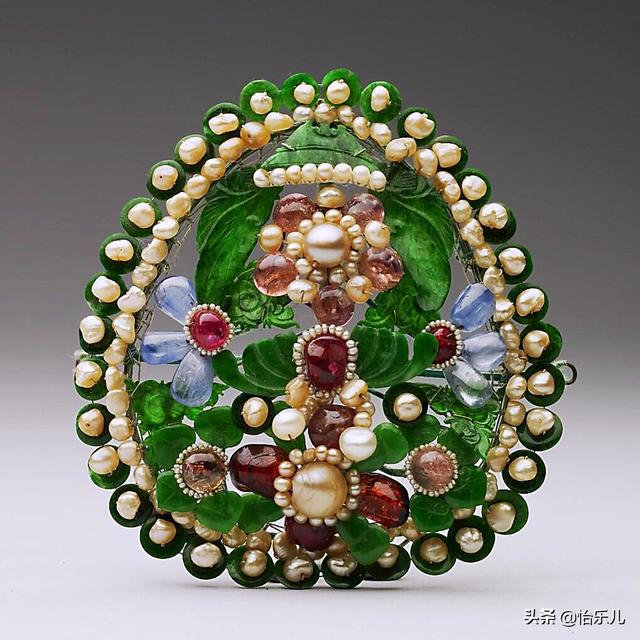A very rare jadeite, pearl and gemstone-inset headdress and necklace set, 19th century
Lot 52. A very rare jadeite, pearl and gemstone-inset headdress and necklace set, 19th century. The headdress 19cm (7 1/2in) wide; the necklace 58cm (22 3/4in) long.Sold for HK$ 940,000 (€ 99,905). © Bonhams.
The pierced metal silk-woven arched frame elaborately decorated with delicate spring-mounted blossoming sprigs embellished with jadeite, pearl, tourmaline, sapphire and other semi-precious materials below a row of tourmaline beads and above a row of miniature jadeite coins, all within a beaded pearl border, each side of the headdress with a temple pendant applied with similar decorations, together with a seed-pearl necklace suspending jadeite and tourmaline pendants.
Published and Illustrated: Chen Kuei-miao, the Jade-Carving Art in the Ch'ing Dynasty, Taipei, 1990, p.174
Chen Kang-shuen, National Museum of History Newsletter, Taipei, 1991, p.3
Gildo Fossati, The World of Jade: Great Masterpieces of Chinese Art, Italy, 1992, p.198
Terese Battesti and Henri-Jean Schubnel, Jades Impériaux, Paris, 1993, p.28, no.89.
Exhibited: South African Cultural History Museum, Chinese Jade Exhibition, Cape Town, 1991, p.9
Transvaal Museum, Chinese Jade Exhibition, Pretoria, 1991, no.9
National Museum of History, Exhbition of Ch'ing Dynasty Carved Jade, Taipei, 1992, p.1
The Museum of Far Eastern Antiquities, Jade from the Qing-dynasty, Stockholm, 1993
Muséum National D'histoire Naturelle, Jades Impériaux, Paris, 1993, no.89
Museum Reich der Kristalle, Jade aus der Qing-Dynastie, Munich, 1993.
Note: The richly adorned headdress and temple pendants belong to a group of delicately crafted ornaments made for further decoration of the Imperial headdress known as dianzi. When worn, a dianzi can be further decorated by insertion of delicate ornaments inlaid with kingfisher feathers, jadeite carvings and other precious materials.
The arched form of the present lot is very similar to two gold headdress ornaments, one dated to the Jiaqing period and another to the Qianlong period, both in the Palace Museum, Beijing. They are known as tiaotou and are used as ornaments attached to the forehead of a dianzi headdress, see Jewellery and Accessories of The Royal Consorts of Ching Dynasty, Hong Kong, 1992, nos.198 and 199.
Jadeites of bright emerald green colour but cut into slices of decorative ornaments are known as guangpian, which literally means 'Guangdong slice', since such technique was likely originated in the Guangdong region. There are a number of headdress ornaments from the Imperial collections with decorated with guangpian jadeite carvings, see a related gold headdress ornament with kingfisher feather inset with pearls, semiprecious stones and jadeite, Qing dynasty, in the National Palace Museum, Taipei, illustrated in A garland of Treasures: Masterpieces of Precious Crafts in the Museum Collection, Taipei, 2014, pl.II-24; and another related jadeite headdress inlaid with pears, tourmaline and sapphire, in the National Palace Museum, Taipei (acc. no.Z.Y.000013). See also four similarly decorated gilt-silver hairpins in the Palace Museum, Beijing, all inlaid with guangpian-style jadeites and other precious stones, Qing dynasty, illustrated in Jewellery and Accessories of The Royal Consorts of Ching Dynasty, Hong Kong, 1992, nos.131-134.
A gold headdress ornament with kingfisher feather inset with pearls, semiprecious stones and jadeite, Qing dynasty. Image courtesy of National Palace Museum, Taipei.
Bonhams. Fine Chinese Art. Introducing Beauty and Beyond: Women in Chinese Art, Hong Kong, 27 May 2021.

/https%3A%2F%2Fprofilepics.canalblog.com%2Fprofilepics%2F1%2F0%2F100183.jpg)
/https%3A%2F%2Fstorage.canalblog.com%2F03%2F02%2F119589%2F96711876_o.jpg)
/https%3A%2F%2Fstorage.canalblog.com%2F11%2F31%2F119589%2F94773502_o.jpg)
/https%3A%2F%2Fstorage.canalblog.com%2F20%2F83%2F119589%2F94772815_o.jpg)
/https%3A%2F%2Fstorage.canalblog.com%2F26%2F72%2F119589%2F75604929_o.jpg)
/https%3A%2F%2Fstorage.canalblog.com%2F59%2F60%2F119589%2F26458628_o.jpg)






/http%3A%2F%2Fstorage.canalblog.com%2F00%2F00%2F119589%2F129758935_o.jpg)
/http%3A%2F%2Fstorage.canalblog.com%2F29%2F28%2F119589%2F129637299_o.jpg)
/http%3A%2F%2Fstorage.canalblog.com%2F88%2F37%2F119589%2F129631480_o.jpg)
/http%3A%2F%2Fstorage.canalblog.com%2F77%2F79%2F119589%2F129631259_o.jpg)